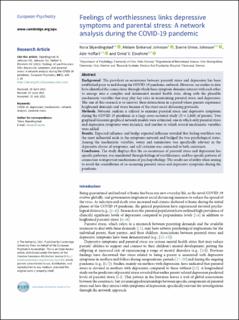| dc.contributor.author | Skjerdingstad, Nora | |
| dc.contributor.author | Sinkerud Johnson, Miriam | |
| dc.contributor.author | Johnson, Sverre Urnes | |
| dc.contributor.author | Hoffart, Asle | |
| dc.contributor.author | Ebrahimi, Omid Vakili | |
| dc.date.accessioned | 2022-03-21T14:38:14Z | |
| dc.date.available | 2022-03-21T14:38:14Z | |
| dc.date.created | 2021-07-27T08:23:50Z | |
| dc.date.issued | 2021-07-27 | |
| dc.identifier.citation | European psychiatry. 2021, 1-28. | en_US |
| dc.identifier.issn | 0924-9338 | |
| dc.identifier.issn | 1778-3585 | |
| dc.identifier.uri | https://hdl.handle.net/11250/2986601 | |
| dc.description.abstract | Background. The prevalent co-occurrence between parental stress and depression has been established prior to and during the COVID-19 pandemic outbreak. However, no studies to date have identified the connections through which these symptom domains interact with each other to emerge into a complex and detrimental mental health state, along with the plausible mechanistic variables that may play key roles in maintaining parental stress and depression. The aim of this research is to uncover these interactions in a period where parents experience heightened demands and stress because of the strict social distancing protocols.
Methods: Network analysis is utilized to examine parental stress and depressive symptoms during the COVID-19 pandemic in a large cross-sectional study (N = 2,868) of parents. Two graphical Gaussian graphical network models were estimated, one in which only parental stress and depression symptoms were included, and another in which several mechanistic variables were added.
Results: Expected influence and bridge expected influence revealed that feeling worthless was the most influential node in the symptoms network and bridged the two psychological states. Among the mechanistic variables, worry and rumination was specifically relevant in the depressive cluster of symptoms, and self-criticism was connected to both constructs.
Conclusion: The study displays that the co-occurrence of parental stress and depression has specific pathways, was manifested through feelings of worthlessness, and has specific patterns of connection to important mechanisms of psychopathology. The results are of utility when aiming to avoid the constellation of co-occurring parental stress and depressive symptoms during the pandemic. | en_US |
| dc.language.iso | eng | en_US |
| dc.publisher | Cambridge University Press | en_US |
| dc.relation.ispartofseries | European psychiatry;Volume 64, Issue 1, 2021, e50 | |
| dc.rights | Navngivelse 4.0 Internasjonal | * |
| dc.rights.uri | http://creativecommons.org/licenses/by/4.0/deed.no | * |
| dc.subject | COVID-19 | en_US |
| dc.subject | Depression | en_US |
| dc.subject | Mechanisms | en_US |
| dc.subject | Network analyses | en_US |
| dc.subject | Parental stress | en_US |
| dc.title | Feelings of Worthlessness Links Depressive Symptoms and Parental Stress: A Network Analysis during the COVID-19 Pandemic | en_US |
| dc.type | Peer reviewed | en_US |
| dc.type | Journal article | en_US |
| dc.description.version | publishedVersion | en_US |
| dc.rights.holder | © The Author(s), 2021 | en_US |
| dc.source.articlenumber | e50 | en_US |
| cristin.ispublished | true | |
| cristin.fulltext | original | |
| cristin.qualitycode | 2 | |
| dc.identifier.doi | https://doi.org/10.1192/j.eurpsy.2021.2223 | |
| dc.identifier.cristin | 1922731 | |
| dc.source.journal | European psychiatry | en_US |
| dc.source.volume | 64 | en_US |
| dc.source.issue | 1 | en_US |
| dc.source.pagenumber | 1-10 | en_US |

